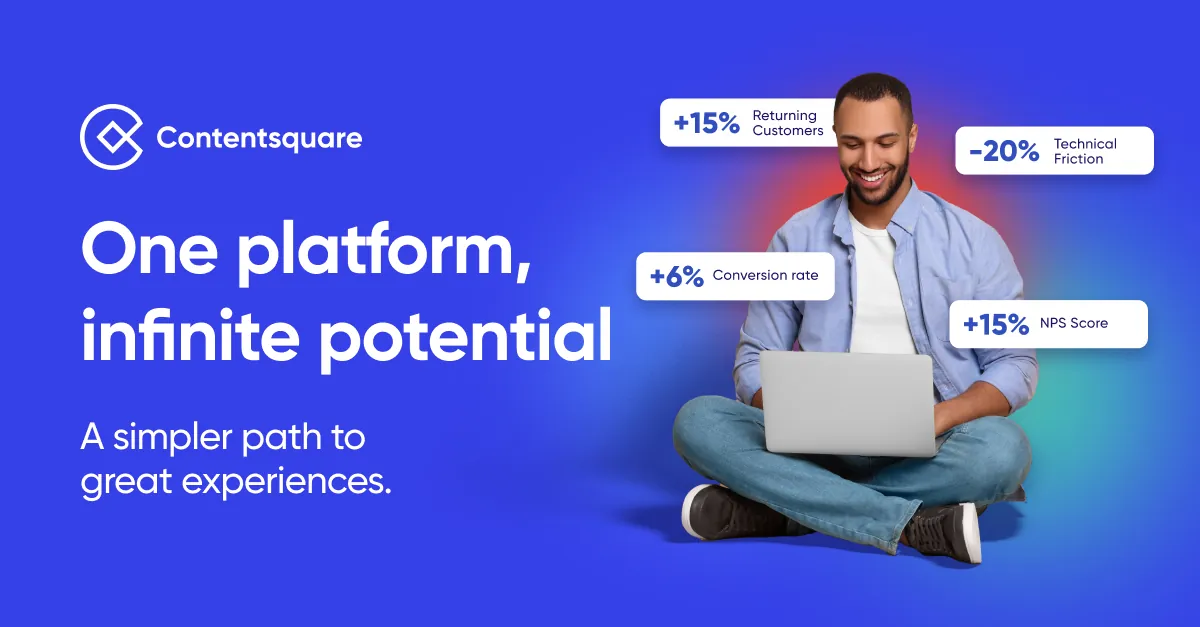A simpler path to great customer experiences

According to Gartner, organizations are spending 25.4% of their marketing budget on technology. At the same time, teams are using only a third of their stack’s capability. And it’s going down. Biggest impediment? The sheer “complexity and sprawl” of the current MarTech ecosystem.
In the realm of Customer Experience (CX), the accumulation of underused tech is hardly proving to be a winning strategy. And just like martech abandonment, customer frustration is also on the up. This year, we analyzed 200 Billion web page views for our annual Digital Experience Benchmark, and found that almost 40% of all browsing has some element of frustration. That’s nearly 1 out of every 2 sessions with issues.
Two things seem obvious: 1) juggling too many tools is getting in the way of making a dent in the so-called “the CX gap,” and 2) the current system for understanding customers is failing to answer the one question that matters:
How do you enhance customer retention and loyalty?
One platform, four analytics domains
Here at Contentsquare we are simplifiers. If the goal is to create seamless customer journeys, then the path to building these experiences should also be seamless. That’s one of the challenges we’re addressing with our newly announced Experience Intelligence platform, which we’ve been working on ever since we acquired Hotjar in 2021 and Product Analytics leader Heap in 2023.
Instead of watching teams toggle between multiple (essential) solutions to understand their customers, we’ve been building a platform that connects for the first time four separate analytics domains — Digital Experience Analytics (DXA), Digital Experience Monitoring (DEM), Product Analytics (PA), and Voice of Customer (VoC).
Working with disconnected data sources towards the same goal doesn’t make sense. It might seem logical, but that’s not how it works today. Think about it — if you have four teams in your organization working on making customers happy, shouldn’t they all be working from the same, unique source of customer understanding?
Whether your focus is acquisition, engagement, retention or site performance, you’re still working towards the same, overall outcomes: higher satisfaction, retention and business growth.
With a unified view of customer data, teams can build a shared and complete understanding of their customers. They can share insights without it being a headache, align their strategies, and reduce miscommunication and duplicative efforts. That means more informed decision-making, more consistency, and quicker responses to changes.
The end-to-end customer journey
The other problem is that today, many brands are only analyzing steps in the customer journey — not the entire customer journey, from A to Z. This limited view misses out on the broader context of customer interactions, leading to fragmented insights, broken experiences and missed opportunities.
Focusing on isolated events like a single web visit or a one-time transaction (a trip), without considering how these individual interactions fit into the larger narrative of the customer’s relationship with the brand, fails to capture the full complexity and potential of the customer experience.
A journey, on the other hand, is the sum of interactions between a customer and a brand. It happens over time, across devices, online and offline. Understanding the entire journey requires connecting these disparate moments into a cohesive whole, revealing patterns and insights that can drive more personalized and more engaging experiences.
By combining the granular insights provided by Digital Experience Analytics with the journey insights provided by Product Analytics, our platform gives teams greater visibility into the overall customer journey — in other words, the insights needed to fuel a strategy that can impact acquisition, retention, NPS, and Customer Lifetime Value (CLV). This holistic view is needed to empower teams to move beyond surface-level metrics and dive deeper into the behaviors, preferences, and emotions that drive customer decisions.
With a comprehensive understanding of the customer journey, brands can build more effective strategies, from personalized marketing campaigns to optimized product experiences. And who wouldn’t want that 🙂
Contextualizing customer feedback for better decision-making
Different types of data tell different kinds of stories. And when it comes to telling the story of how your customers feel about the experience you provide, you want to know each and every plot twist.
With our new platform, we’re making it easy for teams to listen to their customers at scale, and to understand the context behind direct customer feedback. Central to this is the addition of our native, AI-powered Voice of Customer (VoC) capability, which we’re bringing over from Hotjar to give our customers access to qualitative data. This tool allows teams to launch surveys in seconds and receive feedback in minutes, providing immediate insight into customer sentiment.
Gathered from direct customer feedback, these qualitative insights add context and depth to the numbers, revealing the reasons behind the behaviors and the emotions driving customer decisions. This completely transforms teams’ ability to move fast to address customer concerns and act on Net Promoter Score (NPS) at a granular level.
Our aim with this integration is not only to improve the accuracy of customer insights but also to enhance the ability to identify and prioritize areas for improvement. Teams can now seamlessly correlate specific user actions with feedback, uncovering pain points and opportunities that might have otherwise gone unnoticed.
In praise of practical AI
Analytics, just like many other martech tools, has an adoption problem today. With a lot of B2B tech, it can be hard for brands to get to and sustain value without having to rely on individuals with a specific skill set. From the start, our bet was to create analytics for non-analysts.
AI offers an unprecedented ability to help address this adoption problem. That’s why we’ve been exploring how we can use AI to make workflows seamless and perhaps more importantly, give teams the speed that is necessary for a continuous optimization strategy. We like to think of it as practical AI.
Today, we’ve integrated AI-powered insights across the platform to help tell that customer story across multiple data points and, more importantly, make it actionable.
Our AI-powered Frustration Score, for instance, has a 10 to 100x factor, allowing you to detect areas where users are experiencing difficulties in seconds instead of minutes.
It flags friction points automatically so teams can focus on the fixing rather than the excavating of issues.
We have also added Headlines to our homepage — a brand new capability that improves friction discoverability by automatically surfacing key business metric fluctuations and other CX performance highlights. For brands that translates into more confidence in decision-making and quicker time to value.
Similarly, our generative AI-powered CoPilot accelerates the onboarding of new users inside our Product Analytics module, and provides the fastest path to actionable insights. Teams can now ask analytics questions in natural language, and our CoPilot will help them choose the right chart, events, segments, properties, filters, and groupings automatically. You can also ask follow-up questions, such as “how does this vary by marketing channel?” or “what should I look into next?” and get a personalized response that allows you to move fast and effectively.
We’re also leveraging gen AI to revolutionize our VoC product with auto-generated surveys and sentiment analysis to help teams understand customer sentiment at scale. With one-click surveys and one-click reports, it is one of the most self-serve product on the market today.
Our solution automatically captures comprehensive behavioral and performance data across web and apps, drawing insights from 4 analytics domains and millions of websites. This opens up infinite possibilities of training your own model around a comprehensive view of customer behavior, preferences, expectations and trends.
Conclusion
Reducing the complexity of martech stacks and empowering brands to deliver superior customer experiences. That’s what our 580+ Product and R&D team has been working on these past few months and years.
By addressing the fragmentation of analytics tools, we’ve made what is perhaps our biggest leap forward yet.
Customers in 2024 don’t want to compromise. They want rich and engaging experiences that are also intuitive. They want to be wowed without being slowed down. They want personalization they can trust. They want meaningful interactions that remain convenient and blend into their everyday lives. And we think they should have them.
We also think the people who are building those experiences should have access to the most sophisticated understanding of their customers that is possible without any of the hassle of decoding data. We’re Contentsquare, and we can’t wait to partner with you to revolutionize customer experience.



